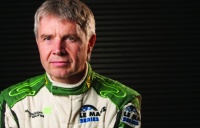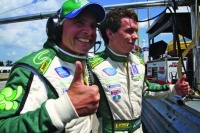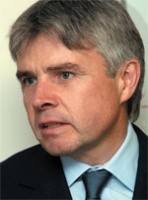
As cars hurtled around the Road Atlanta race track at speeds of up to 200mph, Lord Paul Drayson was concerned with just one thing- achieving a decent time in the night qualifying practice at the 2008 Petit Le Mans. With a last look over his 007-numbered Aston Martin, Drayson was ready to get in the car when his phone started flashing with a call from the then prime minister, Gordon Brown.
The call was to invite Drayson back into government as minister of state for science and innovation. A year earlier he had left his position as defence procurement minister to pursue his dream of competing in the Le Mans 24-hour race. The prime minister, however, believed that the country had lost one of its most valuable politicians. Brown offered Drayson a position on the cabinet as science minister and agreed that he could continue racing.
It would be a tough post and Drayson knew it. The UK was heading into recession and long-term science and engineering funding were being threatened by hard-nosed politicians in favour of short-term gain. But for a man passionate about technology and addicted to the thrill of a new challenge, it was an opportunity too good to miss. ’The number-one difficulty was going into the financial crisis and maintaining investment in the science budget,’ he said. ’That was my biggest concern.’
Over the next few years, Drayson became admired in both political circles and in industry. Despite the controversy surrounding his large donations to the Labour Party, Drayson’s passion for engineering marked him out from his predecessors. He claims his experience in racing taught him how to balance risk and achievement, and his skill in creating a multi-million-pound company gave him a good understanding in the world of business. It seemed the UK had a science minister who knew what he was talking about.

’I guess I’m a combination of an engineer and a businessman who has spent a very interesting seven years in politics,’ said Drayson. ’There is definitely a need for more science and engineering expertise within government. It’s something the UK civil service needs to encourage more.’
Now that his role has been taken over by Tory science minister David Willetts, Drayson is keen that his hard work isn’t undone. He believes the government needs to provide a clear strategy on how it will grow Britain’s science and engineering base. In his view, resources should be allocated to areas where the UK already has a competitive advantage a move that some believe could threaten the breadth of the country’s disciplinary excellence.
’What I’d like to see from the government is more clarity,’ he said. ’They’ve focused a lot on austerity and where cuts can be made, but how can we deliver growth? We need a clear strategic view. The growth is going to come from those sectors that have potential and where the UK has a critical mass. So, if you look at motorsport, it’s an example of a sector where the UK leads the world.’
Motorsport is an area that Drayson remains keenly involved in as president of the Motorsport Industry Association (MIA) and owner of racing team Drayson Racing. Last year the team pioneered the use of a second-generation bio-ethanol fuel and was the first to win a race in a car running entirely on recycled biomass. The group has recently secured a deal with Lola Cars to develop an all-electric prototype race car, the Lola-Drayson B12/69EV. It hopes to eventually race the car in the planned Fédération Internationale de l’Automobile (FIA) electric-car championship in 2013.

’You have to remember that market shares change more dramatically during a recession in tough markets as they do in good markets. The opportunity for successful business people to do even better is greater, so [they should] seize the opportunity. Things change faster in these circumstances and often the weaker players will fall by the wayside because markets are tough and not growing. So that’s a chance for good businesses and good engineers to succeed.’
In his seven years as a politician, Drayson claims that he learnt one important lesson- people are only motivated to do things when they are offered a better alternative. That’s the job of an engineer he argues, ’I’m optimistic, but it will be the engineers, with some help from politicians, who will be the ones to achieve it.’
Q&A Motor head
Where did your passion for science and engineering come from?
I think it goes right back to when I was a little boy. I grew up in Kent near Brands Hatch circuit. I used to go and watch motor racing with my Dad and I remember with the Daily Telegraph, I think it was you used to be able to save up coupons to acquire drawings of ships and aircraft, and stuff like that. I used to love having them in my room. I just got really fascinated with how things worked and I particularly loved things that went quickly.
How would you describe the experience of driving an electric race car?
The big difference is you get 100 per cent of the torque at zero revs. So with an internal combustion engine you have a torque curve where you have a sweet spot at, say, 7,000rpm where the engine produces maximum torque. The thing that is staggering about an electric drive is youget all of the torque straight off and the torque curve is largely flat until it gets towards peak revs before it starts to drop off, so it makes the car very flexible and quite a handful. I think people will be surprised how exciting the cars are.
Of all the cars you’ve raced, which is your favourite?
So far, the LMP1 Lola-Judd we raced in the Le Mans championship last year. Winning in Red America, it was a result. That is definitely my favourite at the moment. Ask me again when we’ve won an electric race.
Are we losing our best engineering talent to other countries?
One of the things I noticed when I was working in the biotechnology industry and we had a research lab in Silicon Valley was how many Brits were working there. It’s remarkable and I think British engineering talent has long worked all over the world. I absolutely see that as a strength. What we need to do is make sure our UK-based businesses are able to source the skills that they need and we’re starting to see certain skills shortages. I think that requires doing a better job of communicating to young people where the job opportunities are and what types of skills are going to be needed over the next 10 to 15 years.
What advice would you give a young person choosing a career in engineering?
I feel hugely fortunate that Ihave been able to spend my life doing something I reallylove doing. So my advice would be to do what you love and, if you really work hard at it, you’ll get really good at it and then you’ll be successful. So if you have a passion for technical things and why things work, and you’re prepared to work at it, you’ll be good at it. There is a shortage of people like that, so the job opportunities for well-motivated, well-trained engineers and scientists are enormous.

Paul Drayson biography
President -Motorsport Industry Association
Education
BSc in production engineering from Aston University; PhD in robotics
Career
1986 Managing director, Lambourn Food Company
1993 Co-founder and chief executive of PowderJect
2004 Raised to the peerage as Baron Drayson of Kensington
2005 Appointed under-secretary of state and minister for defence procurement, and government spokesman for defence in the House of Lords
2007 Promoted to minister of state for defence equipment and support, and became a minister of state in the newly created Department for Business, Enterprise and Regulatory Reform
2008 Rejoined government as minister of state for science and innovation after leaving to concentrate on racing
2009 Competed in Le Mans, finishing 37th overall and 12th in class




Glasgow trial explores AR cues for autonomous road safety
They've ploughed into a few vulnerable road users in the past. Making that less likely will make it spectacularly easy to stop the traffic for...